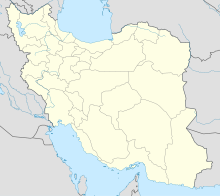Gol Gohar, or Gol-e Gohar (Persian:گل گهر), is the largest iron ore mine in Iran.[3] It has a total iron ore reserve of 1.135 billion tons,[4]: 709 and produces about 11 million tons of iron annually as of 2006.[2] It is located about 55 km southwest of the city of Sirjan and is roughly equidistant from the cities of Kerman, Shiraz, and Bandar Abbas.[4]: 709
 One of the pits at Gol Gohar | |
| Location | |
|---|---|
| Location | Near Sirjan |
| Province | Kerman |
| Country | Iran |
| Coordinates | 29°05′34″N 55°19′35″E / 29.09272°N 55.32643°E[1] |
| Production | |
| Products | Iron ore |
| Production | 11 million tons[2] |
| Financial year | c. 2006 |
| Type | Open-pit[2] |
| History | |
| Opened | 1994 |
The Gol Gohar deposits consist of 6 different deposit areas, or "anomalies", in a space of about 10 km by 4 km area.[4]: 709 Areas 1 and 2 have been fully mapped, and area 3 has been partly mapped as of 2003.[5]: 105–6 Mining has been done at area 1 since 1994; area 3 has the most extensive iron ore deposits; the other areas are relatively small and as of 2003 there were no plans to explore them further.[5]: 105–6
History edit
Iron ore has been mined at Gol Gohar for an estimated 900 years; a large underground mine and smaller open-pit mine in the center of the area used to exist as traces of historical mining activity, but activity since the 20th century has mostly erased these traces.[5]: 105 An estimated 350,000 tons of iron ore were extracted from the old mines at Gol Gohar over the course of their existence.[5]: 105
In 1969, the Iran Barite Company began exploratory work at the Gol Gohar site; this was then delegated to the National Iranian Steel Industries Co. (or NISIC), a government corporation that now operates under the name National Iran Steel Company.[5]: 105 NISIC then entered into a joint venture with the Swedish company Granges International Mining to continue exploring the deposits.[5]: 105 Exploratory drillings began in 1975 on 6 different areas, and mining activity began in 1994.[5]: 105
Geology edit
The Gol Gohar complex is located in a depression known locally as the Kheyrabad Salt Lake, which itself is located on the northeastern margin of the Sanandaj-Sirjan tectonic-metamorphic belt.[5]: 106 The underlying basement rock consists of Paleozoic metamorphic rocks;[5]: 106 mainly gneiss, mica schist, amphibiolites, quartz schist, marble, dolomite, and calcite.[4]: 709 Above these are Mesozoic and Cenozoic sedimentary rocks and Quaternary alluvial deposits.[5]: 106
The ore body itself is estimated to be lenticular in shape, about 2600 m long from east to west and about 400 m wide from north to south.[5]: 106 Several different proposals have been put forward for how it originated: Ljung (1976) suggested a metasedimentary origin, Muke and Golestaneh (1982-91) proposed a magmatic origin similar to the Kiruna mine in Sweden, Hallaji (1992) argued in favor of a metasomatic origin, and Khalili (1993) proposed a volcanic sedimentary origin.[5]: 106
Gallery edit
References edit
- ^ "Geonames Search". Do a radial search using these coordinates here.
- ^ a b c Oraee, K.; Goodarzi, A. (2006). "Feasibility study of Gol-Gohar iron ore open cast mine operation of Iran". In Cardu, M.; Ciccu, R.; Michelotti, E. (eds.). Mine Planning and Equipment Selection 2006: Proceedings of the Fifteenth International Symposium on Mine Planning and Equipment Selection, Torino, Italy, 20-22 September 2006. Torino: GEAM. ISBN 9788890134241. Retrieved 23 February 2023.
- ^ Assari, Amin (2019). "Defining hydrogeology of the Gohar-Zamin open pit mine, Iran: a case study in a hard-rock aquifer". Hydrogeology Journal. 27 (4): 1479–95. doi:10.1007/s10040-018-01919-4. S2CID 133767328. Retrieved 23 February 2023.
- ^ a b c d Jahani, M.; Taji, Mohammad (August 2015). "Comparison of Empirical Fragmentation Models at the Gol-Gohar Iron Ore Mine". 11th International Symposium on Rock Fragmentation by Blasting: 707–13. Retrieved 23 February 2023.
- ^ a b c d e f g h i j k l Bagherian, A.; Shahriar, K. (2003). "Slope Stability at Gol-E-Gohar Iron Mine" (PDF). 18"' International Mining Congress and Exhibition of Turkey: 105–12. Retrieved 23 February 2023.
